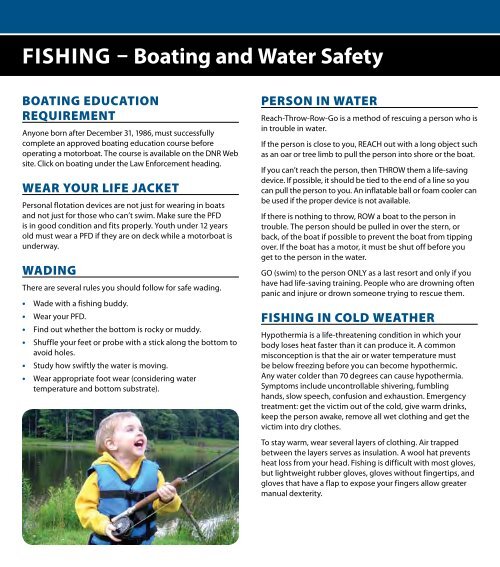District 2 Fishing Guide - West Virginia Department of Commerce
District 2 Fishing Guide - West Virginia Department of Commerce
District 2 Fishing Guide - West Virginia Department of Commerce
Create successful ePaper yourself
Turn your PDF publications into a flip-book with our unique Google optimized e-Paper software.
<strong>Fishing</strong> – Boating and Water safety<br />
BOATING EDUCATION<br />
REQUIREMENT<br />
Anyone born after December 31, 1986, must successfully<br />
complete an approved boating education course before<br />
operating a motorboat. The course is available on the DNR Web<br />
site. Click on boating under the Law Enforcement heading.<br />
WEAR YOUR LIfE JACkET<br />
Personal flotation devices are not just for wearing in boats<br />
and not just for those who can’t swim. Make sure the PFD<br />
is in good condition and fits properly. Youth under 12 years<br />
old must wear a PFD if they are on deck while a motorboat is<br />
underway.<br />
WADING<br />
There are several rules you should follow for safe wading.<br />
• Wade with a fishing buddy.<br />
• Wear your PFD.<br />
• Find out whether the bottom is rocky or muddy.<br />
• Shuffle your feet or probe with a stick along the bottom to<br />
avoid holes.<br />
• Study how swiftly the water is moving.<br />
• Wear appropriate foot wear (considering water<br />
temperature and bottom substrate).<br />
PERsON IN WATER<br />
Reach-Throw-Row-Go is a method <strong>of</strong> rescuing a person who is<br />
in trouble in water.<br />
If the person is close to you, REACH out with a long object such<br />
as an oar or tree limb to pull the person into shore or the boat.<br />
If you can’t reach the person, then THROW them a life-saving<br />
device. If possible, it should be tied to the end <strong>of</strong> a line so you<br />
can pull the person to you. An inflatable ball or foam cooler can<br />
be used if the proper device is not available.<br />
If there is nothing to throw, ROW a boat to the person in<br />
trouble. The person should be pulled in over the stern, or<br />
back, <strong>of</strong> the boat if possible to prevent the boat from tipping<br />
over. If the boat has a motor, it must be shut <strong>of</strong>f before you<br />
get to the person in the water.<br />
GO (swim) to the person ONLY as a last resort and only if you<br />
have had life-saving training. People who are drowning <strong>of</strong>ten<br />
panic and injure or drown someone trying to rescue them.<br />
fIshING IN COLD WEAThER<br />
Hypothermia is a life-threatening condition in which your<br />
body loses heat faster than it can produce it. A common<br />
misconception is that the air or water temperature must<br />
be below freezing before you can become hypothermic.<br />
Any water colder than 70 degrees can cause hypothermia.<br />
Symptoms include uncontrollable shivering, fumbling<br />
hands, slow speech, confusion and exhaustion. Emergency<br />
treatment: get the victim out <strong>of</strong> the cold, give warm drinks,<br />
keep the person awake, remove all wet clothing and get the<br />
victim into dry clothes.<br />
To stay warm, wear several layers <strong>of</strong> clothing. Air trapped<br />
between the layers serves as insulation. A wool hat prevents<br />
heat loss from your head. <strong>Fishing</strong> is difficult with most gloves,<br />
but lightweight rubber gloves, gloves without fingertips, and<br />
gloves that have a flap to expose your fingers allow greater<br />
manual dexterity.

















